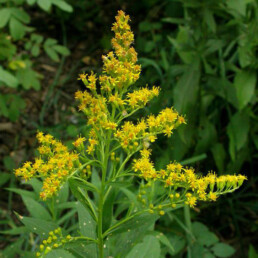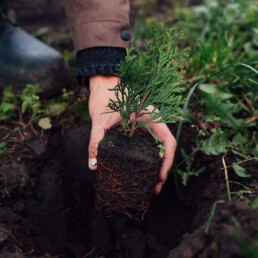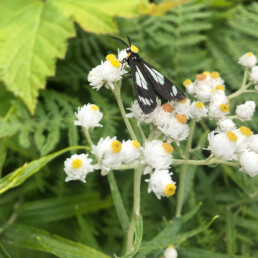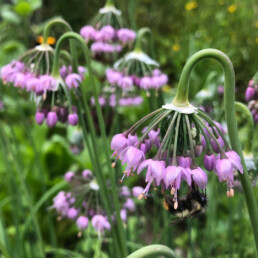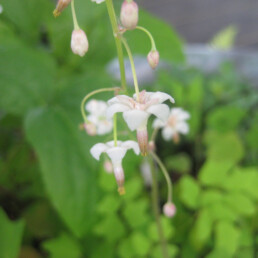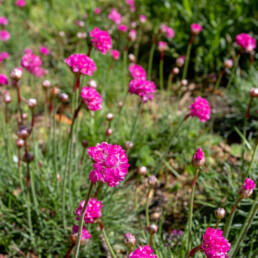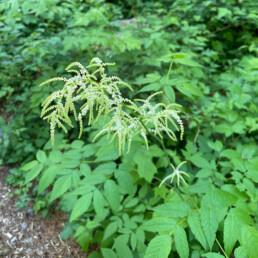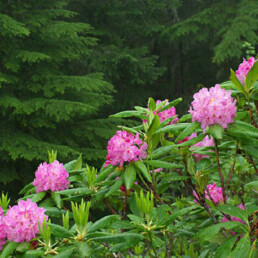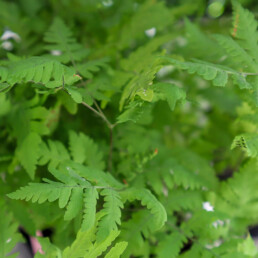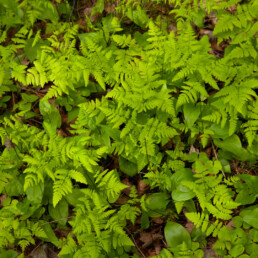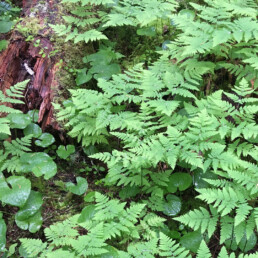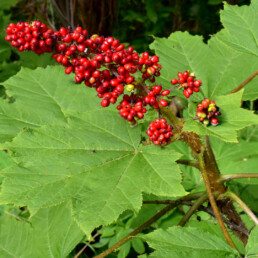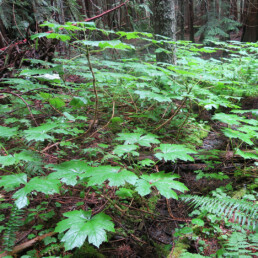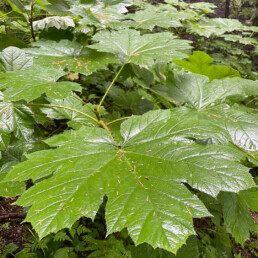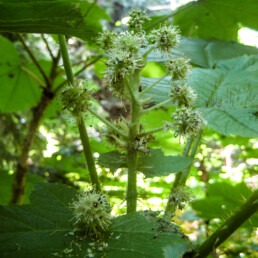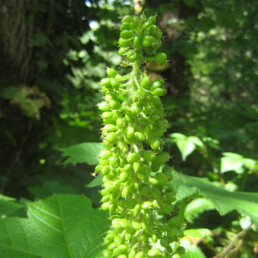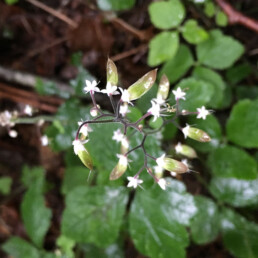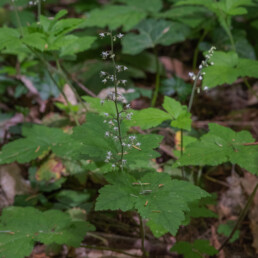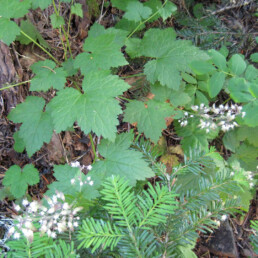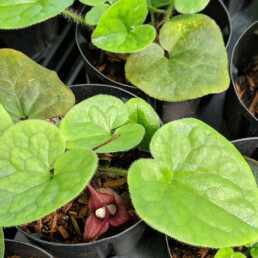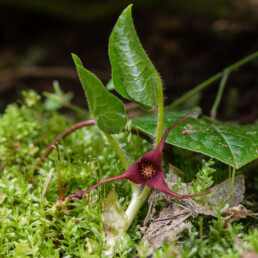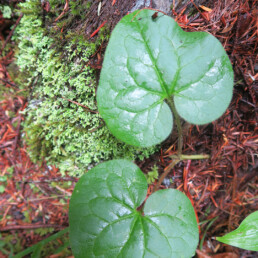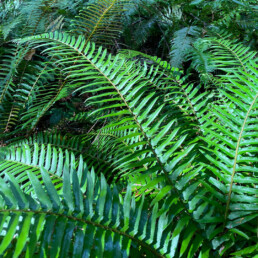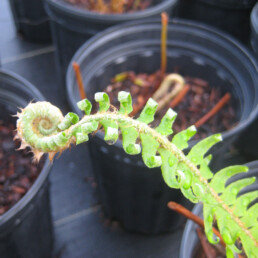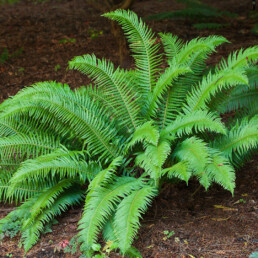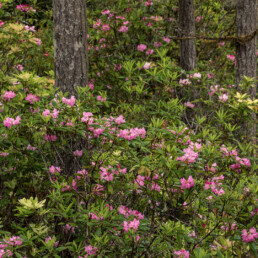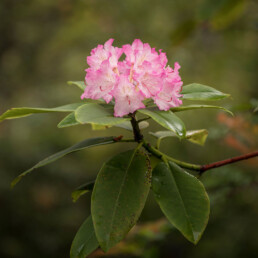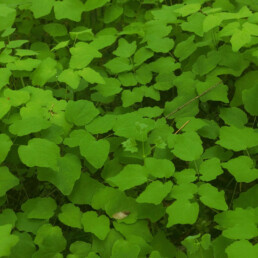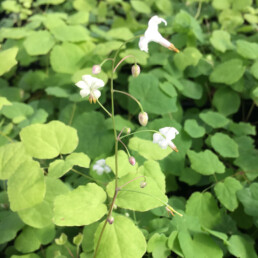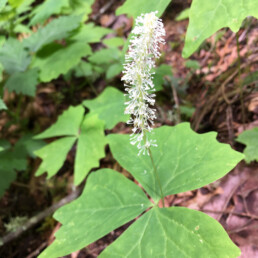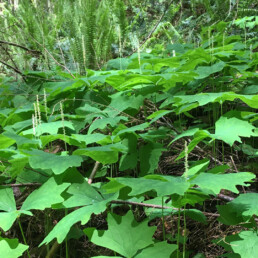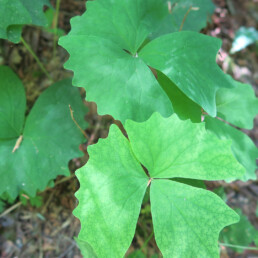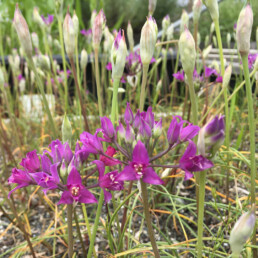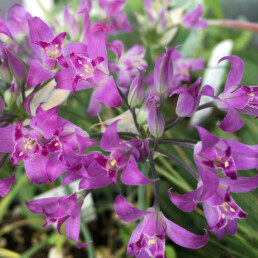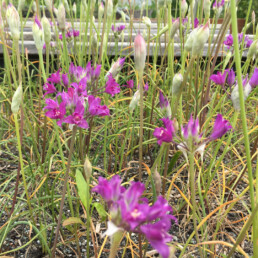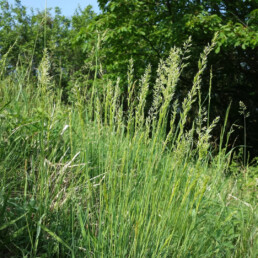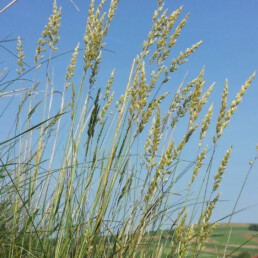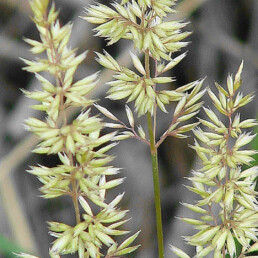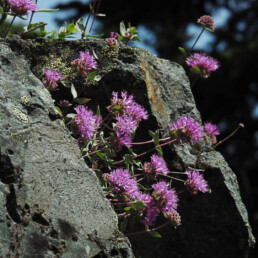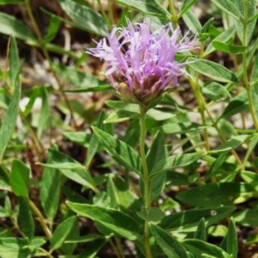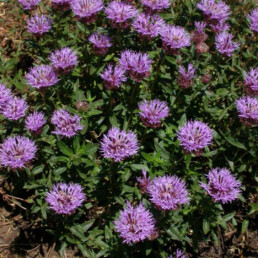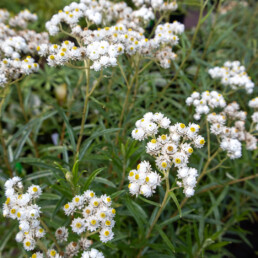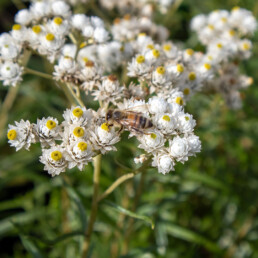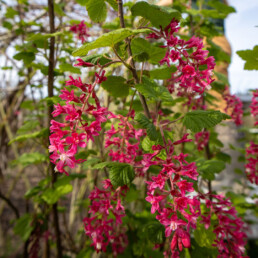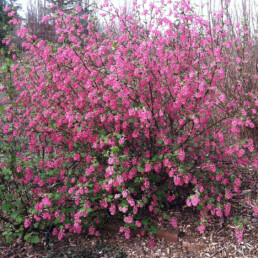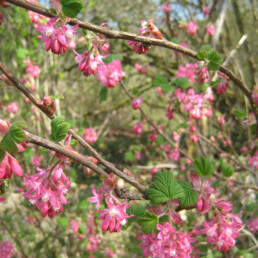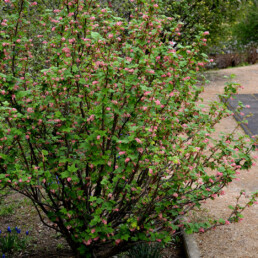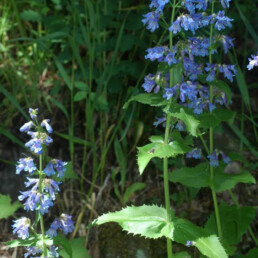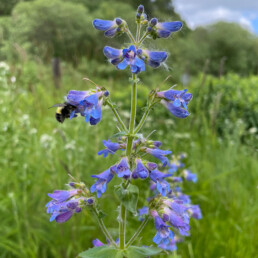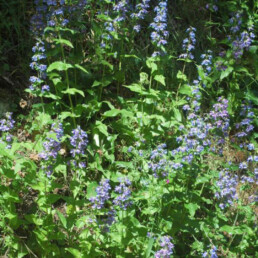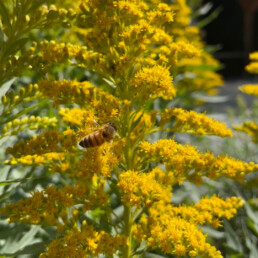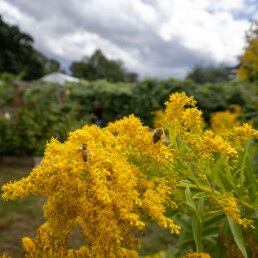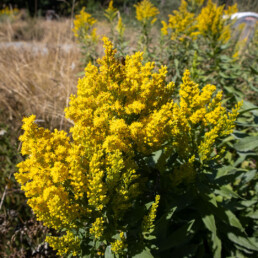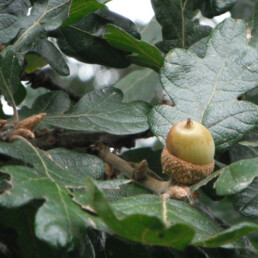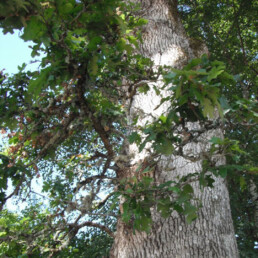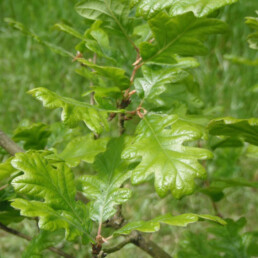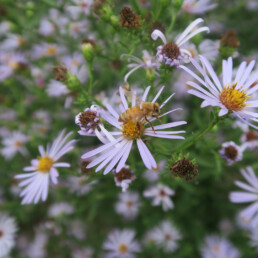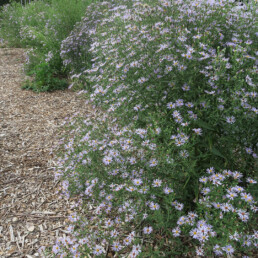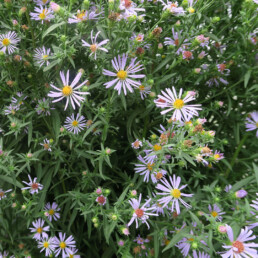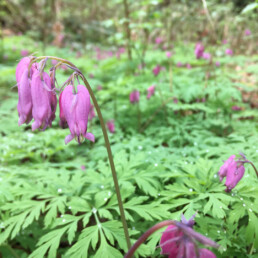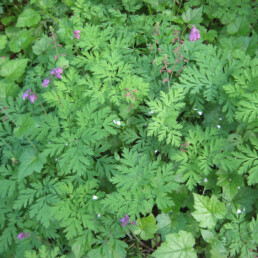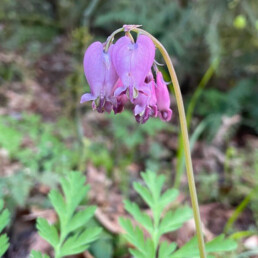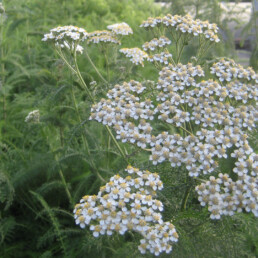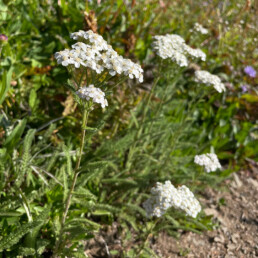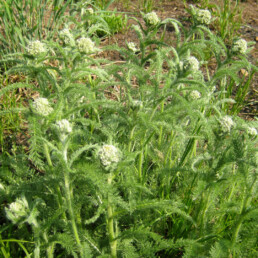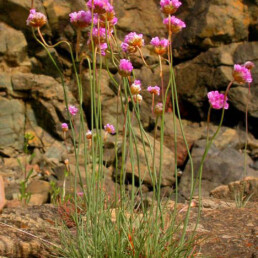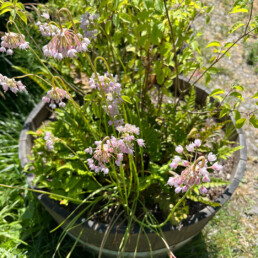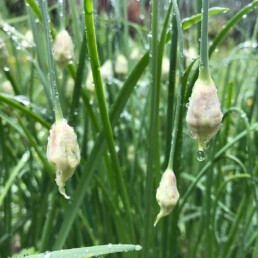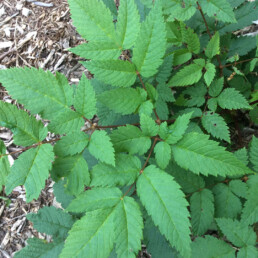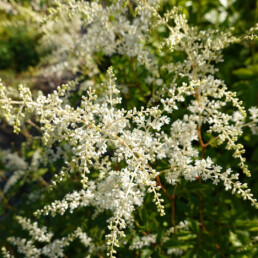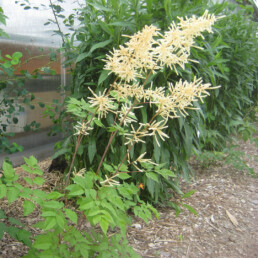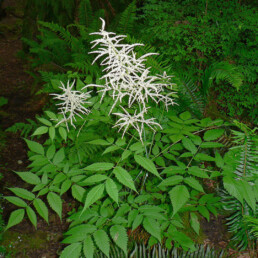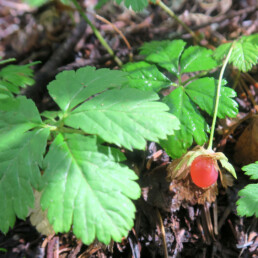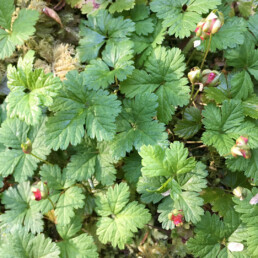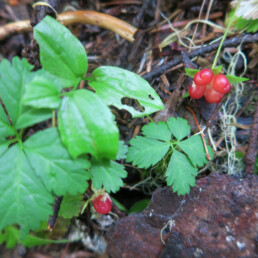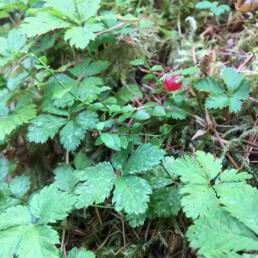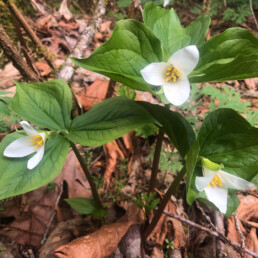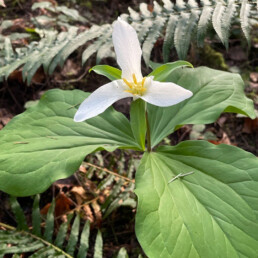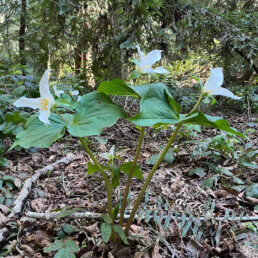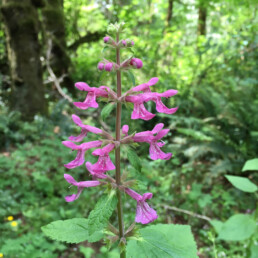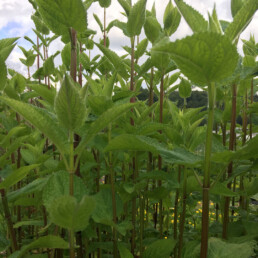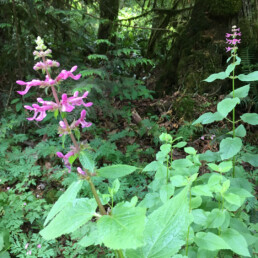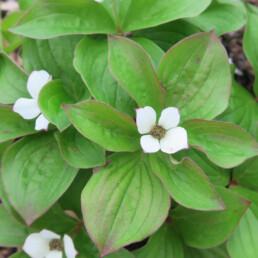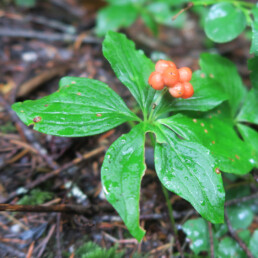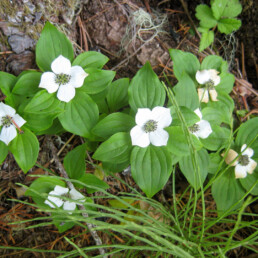Native Plant Picks for All Conditions
Greetings, gardeners! You probably know how important native plants are for maintaining biodiversity and supporting resilient landscapes.
If you’re in western Washington, you also know that fall is the ideal time to plant native perennials, trees, and shrubs so they can establish strong roots and thrive.
But maybe you’re scratching your head, wondering which native plants would grow best in your outdoor spaces? Choosing the right plants can be a challenge, right?
Our Native Plant Nursery Team has put together a list of top recommendations for a variety of conditions.
Whether you are working with a small porch or a sprawling landscape, this guide will help transform your garden into an ecosystem that can provide habitat and sustenance for a community of organisms including pollinators, birds, soil microbes, and humans too!
= Container friendly
Shady & Wet
Scientific Name:
Gymnocarpium dryopteris
Habitat:
Western oakfern is a delicate, low deciduous fern that slowly spreads via rhizomes. Easy to transplant and ideal for ground cover, oakfern creates a lovely green blanket under trees or at the edge of a woodland garden, thriving in deep shade and moist soils rich in organic matter.
Height:
Up to 12″
Additional Notes:
It provides excellent cover for small birds and mammals, making it a great choice for wildlife-friendly gardens.
Scientific Name:
Oplopanax horridus
Habitat:
Devil’s club thrives in full or partial shade with wet or very moist soil, making it ideal for planting near salmon-bearing streams where its broad leaves provide essential shade. This dramatic, spiky deciduous shrub blooms fragrant green-white flowers between May and July, followed by bright red fruit clusters in August-September. Its early blooms attract pollinators, while its large leaves offer cover for birds. Plant away from well-worn paths.
Height:
Up to 10 feet tall
Additional Notes:
Though devil’s club berries are favored by bears, they are not edible for humans. However, its spicy roots and piney leaves make a pungent tea, and the plant has a rich history of medicinal and cultural importance. Used by over 38 indigenous linguistic groups, different parts of devil’s club are applied to treat dozens of physical ailments and for various spiritual purposes.
Further Reading:
American Botanical Council
Scientific Name:
Tiarella trifoliata
Habitat:
Foamflower thrives in shady, moist woodland gardens. This plant spreads slowly via rhizomes and serves as an attractive ground cover. Delicate white flowers bloom on spikes up to 1 foot above the low foliage, from spring through late summer, providing a long season of visual interest.
Height:
8-14″
Additional Notes:
Named foamflower for its delicate blooms that resemble specks of foam, and also known as sugar-scoop for its unique seed capsules shaped like tiny spoons, this lovely saxifrage attracts small bees, flies, and other beneficial insects. It’s a charming addition to any shade garden, particularly at the front of a border, offering both aesthetic appeal and ecological benefits.
Scientific Name:
Asarum caudatum
Habitat:
This semi-evergreen groundcover thrives in full to mostly shade with moist, well-drained soils. Its deep green, heart-shaped leaves persist through winter, providing a consistent green cover. Ginger spreads slowly via rhizomes and makes an excellent ground cover, with unique but inconspicuous maroon-purple flowers blooming from April to July beneath the foliage.
Height:
Up to 8″
Additional Notes:
The fragrant foliage emits a strong ginger-like scent when crushed or rubbed, though it should not be used as a culinary substitute in the same way. The rhizomes can be used in small quantities as a ginger alternative. Additionally, this plant offers winter cover for beneficial insects, contributing both ecological and sensory benefits to shaded gardens.
Shady & Dry/Moist
Scientific Name:
Polystichum munitum
Habitat:
Sword fern is an iconic evergreen fern found throughout the Pacific Northwest, thriving in moist conifer forests. It prefers part shade to full shade and can adapt to dry to moist soils, becoming quite drought tolerant once established. Its upright, evergreen fronds provide year-round texture to the landscape and can be planted in mass for a classic PNW understory feel or interspersed with other plants.
Height:
2-4′
Additional Notes:
Its dense foliage provides excellent nesting and cover for many small mammals and birds, making it a valuable addition to any shaded garden.
Scientific Name:
Rhododendron macrophyllum
Habitat:
This evergreen shrub thrives in partial shade and prefers moist to dry soil rich in organic matter. It is well-suited for gardens where it can provide cover for birds and small mammals.
Height:
Up to 20′
Additional Notes:
Washington’s state flower, this shrub produces clusters of bright pink, showy flowers that bloom from April to May. The flowers attract a variety of pollinators, including hummingbirds, butterflies, bumblebees, and other beneficial insects, adding vibrant color and ecological value to the garden.
Scientific Name:
Vancouveria hexandra
Habitat:
Inside-out flower thrives in moist, shady wooded sites, preferring soil rich in organic matter. It grows well in full to part shade and spreads readily via rhizomes, making it an excellent ground cover under trees or along borders.
Height:
8-16″
Additional Notes:
Delicately dangling white flowers bloom from May to June, creating a lovely display throughout the summer. The prolific seeds, produced in late summer, are enjoyed by birds and are dispersed by ants and sometimes wasps, attracted by a fleshy food growth on the seeds called an elaiosome. This plant is also said to be deer resistant, and its leaflets are charmingly reminiscent of little duck feet.
Scientific Name:
Achlys triphylla
Habitat:
Vanilla leaf thrives in moist soils with partial to full shade, making it an ideal choice for woodland gardens or as an understory groundcover. This herbaceous perennial grows from rhizomes, reaching up to 1 foot tall, and forms a carpet of fan-shaped leaves, spreading easily to create a lush, deciduous groundcover.
Height:
Up to 12″
Additional Notes:
Named for its sweet, vanilla-like scent when dried, Vanilla leaf produces spikes of tiny white flowers that bloom above the foliage from April to July. The dried leaves can be hung in your home, car, or other locations to enjoy their delicate fragrance. This plant not only adds beauty to your garden but also offers a delightful sensory experience.
Sunny & Dry
Scientific Name:
Allium acuminatum
Habitat:
Taper-tip onion thrives in sunny, well-drained areas, often found in open rocky environments and prairies. This small, compact plant grows from a bulb, with grass-like foliage that supports its bright pinkish-purple to white flower clusters, which bloom from May to June.
Height:
4-14″
Additional Notes:
The entire plant, including the flowers and seeds, is edible and has a mild flavor. The plant is a favorite among pollinators, attracting bees and butterflies with its nectar, while birds enjoy its seeds.
Scientific Name:
Koeleria macrantha
Habitat:
Prairie junegrass thrives in full sun and demonstrates excellent drought tolerance. It grows in patchy clusters, with green-blue blades and dense, silvery-green spike-like seedheads that bloom in June. This grass is often used in the restoration of native prairie habitats and makes a great option for alternative lawns.
Height:
Up to 2′
Additional Notes:
Prairie junegrass is a host plant for skipper butterflies and provides early spring forage for livestock, deer, antelope, and elk. The dried flower stalks of this grass can even be used as a paintbrush!
Scientific Name:
Monardella odoratissima
Habitat:
Mountain monardella thrives in dry soil with full to partial sun, making it an ideal choice for rock gardens, borders, and beds.
Height:
Up to 3′
Additional Notes:
Blooming from May through August, mountain monardella displays light purple flowers and has fragrant foliage with a minty scent. Its sweet aroma attracts a variety of pollinators, including butterflies, which are the main pollinators, as well as hummingbirds.
Scientific Name:
Anaphalis margaritacea
Habitat:
Pearly everlasting thrives in full to partial sun and can adapt to both dry and moist soils. It naturally occurs in open and rocky areas. The plant blooms in early to midsummer with white pearl-like flowers that reveal a bright yellow center as they open, and these blooms persist through the fall.
Height:
1-3′
Additional Notes:
The flowers of this plant are not only visually striking but also practical, as they dry well and make excellent additions to bouquets. The flowers provide nectar for pollinators, and the many tiny seeds that form later in the season are enjoyed by birds throughout the fall and winter.
Scientific Name:
Ribes sanguineum
Habitat:
This deciduous, thornless shrub thrives in full to partial sun and tolerates dry, nutrient-poor soils. It is well-suited for landscapes where it can serve as an early spring showstopper, attracting pollinators and providing essential habitat for birds.
Height:
Up to 8-10′
Additional Notes:
In early spring, clusters of bright pink-red flowers bloom, offering nectar for hummingbirds, bees, and other pollinators. By summer, edible black fruit ripen, attracting birds and other wildlife. The flowers can also be brewed into a simple syrup, making a delicious addition to sodas and cocktails.
Pollinator Picks
Scientific Name:
Penstemon ovatus
Habitat:
Oval-leaf penstemon thrives in full to partial sun and prefers moist soil with good drainage. It is well-suited for sunny meadow plantings and can also be grown in pots, where it will signal when it needs water by drooping its leaves. This perennial flower is adaptable, growing well in both dry and moist conditions.
Height:
Up to 3′
Additional Notes:
The striking purple/blue flowers of oval-leaf penstemon are a favorite among hummingbirds and bumblebees, ensuring that these blooms are always buzzing with activity. The plant’s evergreen foliage provides year-round interest.
Scientific Name:
Asarum caudatum
Habitat:
This semi-evergreen groundcover thrives in full to mostly shade with moist, well-drained soils. Its deep green, heart-shaped leaves persist through winter, providing a consistent green cover. Ginger spreads slowly via rhizomes and makes an excellent ground cover, with unique but inconspicuous maroon-purple flowers blooming from April to July beneath the foliage.
Height:
Up to 8″
Additional Notes:
The fragrant foliage emits a strong ginger-like scent when crushed or rubbed, though it should not be used as a culinary substitute in the same way. The rhizomes can be used in small quantities as a ginger alternative. Additionally, this plant offers winter cover for beneficial insects, contributing both ecological and sensory benefits to shaded gardens.
Scientific Name:
Solidago lepida
Habitat:
Western Canada goldenrod thrives in dry to moist areas, typically found in meadows and riparian zones. It is shade intolerant and grows best in full sun to part shade. This plant is well-suited for environments where it can spread by rhizomes, establishing itself as a strong presence in the landscape.
Height:
Up to 3-5′
Additional Notes:
Western Canada goldenrod is a vital late-season bloomer, flowering from July to October, and plays a crucial role in supporting pollinators when other resources are scarce. Its yellow flowers attract a wide range of pollinators, including bumblebees and butterflies like the pine white, red admiral, and Mylitta crescent. This plant is also significant for North American pollinator biodiversity, hosting over 100 different moth and butterfly larvae, making it one of the most important genera for sustaining pollinator populations.
Further Reading:
National Wildlife Federation, “Keystone Native Plants”
Scientific Name:
Quercus garryana
Habitat:
This drought-tolerant, deciduous tree is native to regions west of the Cascades, making it Washington’s only native oak species. Garry oaks thrive in full sun to part shade and prefer dry to moist soils. They are commonly found in open prairies and savannahs, which are habitats currently in decline.
Height:
Up to 80′
Additional Notes:
Garry oaks are slow-growing trees with a broad, spreading, rounded crown and intricate branching patterns. They produce nutritious acorns that serve as a vital winter food source for various species of birds and mammals. Additionally, Quercus species, including Garry oaks, are crucial hosts for approximately 900 species of caterpillars, supporting a diverse array of pollinators and providing a food source for birds. With oak trees facing threats in other parts of North America, particularly from invasive species like the Spongy moth (Lymantria dispar dispar), planting Garry oaks can help preserve this important caterpillar host species and contribute to the conservation of local biodiversity.
Further Reading:
Planting for the Planet
Scientific Name:
Symphyotrichum subspicatum
Habitat:
This rapidly growing perennial thrives in full to part sun and moist soils, though it is also drought tolerant. It is well-suited for adding late-season color to moist woodland gardens or along streambanks.
Height:
3-5′
Additional Notes:
The daisy-like blue-purple flowers bloom from July to September, providing a vital nectar source for pollinators as autumn approaches. Its vigorous spreading nature makes it an excellent choice for gardeners looking to support pollinators while adding vibrant, late-season blooms to their landscape.
Long-lasting Bloomers
Scientific Name:
Dicentra formosa
Habitat:
Bleeding heart thrives in the moist shade of the forest understory, where it can form a lovely carpet of lacy green foliage. This perennial spreads rapidly via seeds and underground rhizomes, making it an excellent ground cover for shaded areas.
Height:
1-2′
Additional Notes:
In the spring, bleeding heart produces unusual, inflated pink heart-shaped flowers that bloom on stalks up to 1 foot above the foliage. These flowers can continue blooming through August. The plant attracts bees and serves as a host for butterfly larvae. Its seeds are dispersed by ants which feed on the fleshy food growth on the seeds called an elaiosome, further aiding in its spread.
Scientific Name:
Achillea millefolium
Habitat:
Yarrow thrives in full sun and is highly drought tolerant, making it an excellent choice for a ground cover or lawn alternative. This evergreen plant can reach up to 2 to 3 feet tall when flowering and spreads primarily through rhizomes. Its soft, fern-like foliage effectively fills in spaces.
Height:
2-3′
Additional Notes:
Yarrow blooms with white or pink flowers from February through October, providing a long season of interest and support for pollinators. It attracts bees, butterflies, and syrphid flies, while also supporting various species of moths, beetles, and wasps. Additionally, it is a valuable companion plant, drawing beneficial insects like predatory wasps, ladybugs, and hoverflies. The fragrant foliage of yarrow has also been used in traditional medicine.
Scientific Name:
Armeria maritima
Habitat:
Sea thrift thrives in full sun and dry to moist conditions, making it well-suited for rocky coastal areas or gravel borders. This herbaceous plant forms compact, semi-evergreen grassy clumps and is easy to grow with a moderate growth rate.
Height:
6-12″
Additional Notes:
In the spring and summer, sea thrift produces ball-shaped pink flowers on stems that reach 6 to 10 inches tall, resembling a lollipop. The dried flower heads can persist into the fall, adding extended visual interest. This plant is also a magnet for pollinators, attracting butterflies, bees, and syrphid flies.
Scientific Name:
Allium cernuum
Habitat:
This herbaceous plant forms grass-like clumps and is well-suited for areas with full to partial sun and dry to moist conditions. It is a great choice for container gardening.
Height:
6-20″
Additional Notes:
Nodding onion produces edible, pale-pink star-like flowers that bloom from May to June, with clusters that “nod” down, possibly to protect the flower parts from spring rain. This plant attracts bees, butterflies, hummingbirds, and other beneficial insects, and is also deer-resistant due to its pungent odor. Every part of the plant is edible, including the bulb and leaves, and it readily spreads from seed, making it a versatile addition to any garden.
Scientific Name:
Solidago lepida
Habitat:
Western Canada goldenrod thrives in dry to moist areas, typically found in meadows and riparian zones. It is shade intolerant and grows best in full sun to part shade. This plant is well-suited for environments where it can spread by rhizomes, establishing itself as a strong presence in the landscape.
Height:
Up to 3-5′
Additional Notes:
Western Canada goldenrod is a vital late-season bloomer, flowering from July to October, and plays a crucial role in supporting pollinators when other resources are scarce. Its yellow flowers attract a wide range of pollinators, including bumblebees and butterflies like the pine white, red admiral, and Mylitta crescent. This plant is also significant for North American pollinator biodiversity, hosting over 100 different moth and butterfly larvae, making it one of the most important genera for sustaining pollinator populations.
Further Reading:
National Wildlife Federation, “Keystone Native Plants”
Scientific Name:
Anaphalis margaritacea
Habitat:
Pearly everlasting thrives in full to partial sun and can adapt to both dry and moist soils. It naturally occurs in open and rocky areas. The plant blooms in early to midsummer with white pearl-like flowers that reveal a bright yellow center as they open, and these blooms persist through the fall.
Height:
1-3′
Additional Notes:
The flowers of this plant are not only visually striking but also practical, as they dry well and make excellent additions to bouquets. The flowers provide nectar for pollinators, and the many tiny seeds that form later in the season are enjoyed by birds throughout the fall and winter.
Staff Favorites
Scientific Name:
Aruncus dioicus
Habitat:
Goatsbeard thrives in moist forests, shady edges, and streambanks, performing well in both partly shady to full sun conditions as long as sufficient soil moisture is provided. In full sun, it has a more upright habit, while in shade, it develops a graceful arching form. This deciduous plant can grow up to 6 feet tall and form a clump up to 5 feet wide over time, making it an excellent choice for the back of a shady border.
Height:
4-6′
Additional Notes:
In summer, goatsbeard produces graceful, feathery plumes of tiny cream-white flowers. These flowers attract a variety of pollinators, including bees, butterflies, hoverflies, and beetles, while birds feed on the seed heads. As a dioecious species, goatsbeard plants are either male or female, but both produce the same elegant panicles of flowers from May to June. Although it dies back to the ground each year, goatsbeard provides year-round interest in the garden and supports numerous native pollinators.
Scientific Name:
Rubus pedatus
Habitat:
This mat-forming, thornless perennial groundcover thrives in full to part shade and moist soil, making it perfect for woodland gardens or spilling over the edges of tall containers. It has a moderate growth rate, reaching only 6 inches in height, and spreads by rooting along its stems and at the tips of its vines.
Height:
6″
Additional Notes:
Delicate white flowers appear in summer, followed by small pink clusters of edible fruit in July. While not actually a strawberry, this plant is more closely related to thimbleberry. Lea describes it best: “It’s just really cute, and I think it gets overlooked.” Its low-lying, charming presence adds a unique and attractive touch to any shaded garden space.
Scientific Name:
Trillium ovatum
Habitat:
Pacific trillium thrives in full shade and moist, well-drained soil rich in organic matter, making it a perfect choice for the understory of moist PNW forests.
Height:
up to 1′
Additional Notes:
This springtime beauty features a whorl of leaves and a single large white flower that fades to pink and then purple as it blooms from March to June. Caitlin notes that trilliums take at least 5 years to grow from seed to bloom, and that the “bulb” is actually a super slow-growing rhizome, which she says reminds her of a snail! The seeds of Pacific trillium are dispersed by ants, attracted by a fatty, nutrient-rich attachment called an elaiosome, which they carry back to their colonies, effectively dispersing and burying the seeds. This plant not only adds elegance to shaded areas but also supports various pollinators and plays a unique role in the ecosystem through its ant-assisted seed dispersal.
Scientific Name:
Stachys cooleyae
Habitat:
Cooley’s hedge nettle thrives in full to partial sun, particularly in moist to wet areas like openings and edges.
Height:
up to 5′
Additional Notes:
With soft, fuzzy leaves that don’t sting, hedge nettle produces bright pink-purple flower spikes in the summer that are loved by hummingbirds. Cherie affectionately calls them “Stinkys” due to their musty aroma, and she adds, “Don’t worry, it won’t sting you! Leaves and stems are soft and hairy. Personally, I love it! Adds a savory flavor to teas (I enjoy it with lemon balm and mullein).”
Scientific Name:
Cornus unalaschkensis
Habitat:
Bunchberry thrives in the moist shade of the forest understory, preferring soils rich in rotting wood or bark. This groundcover does well in part to full shade and moist to wet conditions, making it an excellent choice for shady garden areas.
Height:
4-8″
Additional Notes:
In spring, bunchberry produces cream-colored flowers that attract bees, followed by bright red fruits that are enjoyed by birds. The leaves turn shades of red in the fall, adding seasonal interest. Jess notes, “My favorite part are the beautiful leaves, whose strong venation is representative of the rest of the dogwood family!”
Keep growing!
We hope this list helps take the guesswork out of your native plant gardening. But don’t stop here—there’s so much more to explore! Check out our blog post on “Unexpectedly Edible Native Plants” to discover some of western Washington’s wild and delicious surprises. And while you’re at it, dig into our resources page for planting tips, mindful foraging practices, and ways to attract beneficial insects. Together, we can grow more beauty and biodiversity in our ecoregion.

